REINCARNATION .
.
.
LIFE:
Interesting facts about B12, iron, calcium, zinc, iodine, and selenium. I love Hildesheim. Eating millet with hands.
September 24, 2024.
Good morning. It's just before eight. I was woken up by the street cleaning and feel only moderately well-rested. So I lay in bed for a while longer, listening to a podcast about eating with hands.
When I went into the kitchen, I saw a large puddle of water on the floor. I had completely forgotten that when defrosting the fridge, the freezer compartment would defrost, and the ice would melt...
After cleaning up, I decided to go for my very first micronutrient analysis. Lately, I've often heard that it doesn't make much sense to take supplements blindly. It's much better to check nutrient levels and then supplement specifically if there is a deficiency. That's why I made an appointment at Nordlab here in Hildesheim for tomorrow, and I will test all the nutrients that could be critical in a vegan diet.
Some critical values are already in my mind, like zinc, selenium, iodine, B12, and ferritin (iron storage). But I will sit in a café and look into the critical values and what the optimal levels are.
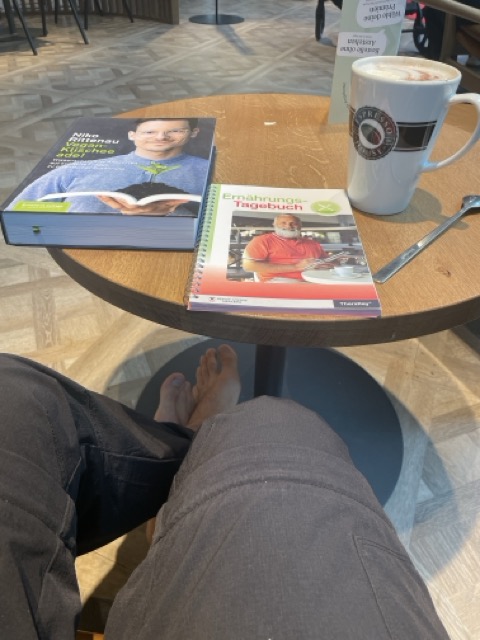
I got myself a hot chocolate with soy milk and got to work noting down the nutrients I will have tested tomorrow. Niko Rittenau's book is perfect in this context.
The most important nutrient I will test is vitamin B12. Here are some things I didn't know about B12:
- I should prefer the Holo-TC test because it's the most accurate. Optimal value: from 400 ng/l. Alternatively, serum B12 can be measured. Optimal value: from 50 pmol/l.
- In the 1950s, there were significant amounts of B12 in water, roots, and soil samples. (Not washing the soil off organic vegetables? 🤔)
- B12 binds to proteins. This happens already in the mouth. This way, B12 can pass through the stomach unscathed. (Better B12 absorption is another reason to chew well and slowly.)
- Not every form of B12 can perform all the tasks in the body that B12 is responsible for. For example, methylcobalamin cannot perform the tasks of adenosylcobalamin.
- As a vegan, I can have enough bioavailable B12 in my stool but still suffer from a B12 deficiency. An extraction of B12 from one's own stool and injection of it corrects the deficiency. (Eating your own stool? 😄)
- Another "natural" B12 source: insects, like worms, in fruits.
- Plants also take up B12 from the soil. However, the concentration in the soil must be very high for vegans to get enough through plants. Fertilizing with cow manure can multiply the B12 concentration in the soil. However, I would still have to eat 3 kg of spinach. So it can't be the only B12 source.
- Humans have a large B12 store (3000 micrograms), which lasts for many years if well-filled.
- High doses of vitamin C reduce the absorption of B12. (Take vitamin C and B12 at intervals of 4 hours.)
- Many medications taken today reduce the absorption of B12. Anesthesia with laughing gas depletes large amounts of B12 stores. 😱
- B12 absorption depends on calcium supply.
After the coffee, I went to Jaaid's vegetable kebab and got a really awesome vegetarian döner – with grilled vegetables, tomatoes, lettuce, and cream cheese, and all for just two euros! Amazing. A really awesome deal!
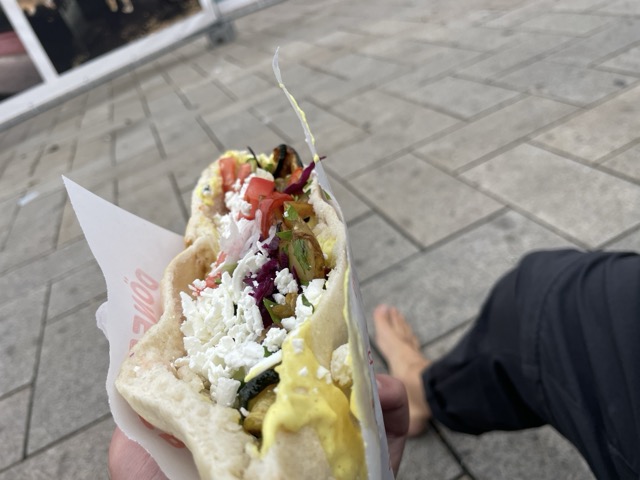
After this boost, I was ready for the city library to continue learning about nutrients.
On the way, I checked out Kaplan Market - Gazi. 1 Euro for 1 kg of nectarines, 1.50 Euros for 1 kg of apples, 1.50 Euros for 1 kg of cherry tomatoes, and 1 Euro for 1 kg of potatoes. Now that's what I call reasonable prices. And everything is unpackaged! 😮

Continuing on to the city library, I also stopped by Samowar Tea House, the shop Beate from the bulk store recommended. They definitely have unpackaged tea in various organic varieties, and even fruit and vegetables, also organic and unpackaged.
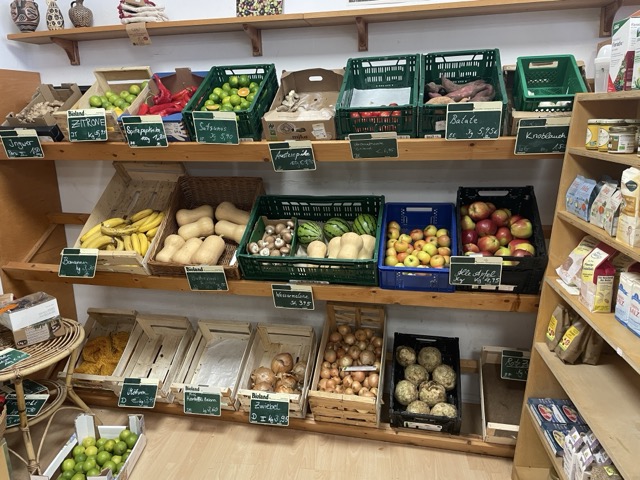
Onward to the city library. I passed by Wine Kusch again and asked the seller if he knew of anywhere in Hildesheim where you can buy unpackaged oils. He said, unfortunately, not anymore, especially since oils, when unpackaged, quickly go rancid and it's not worth it. I disagreed, pointing out that the shop "VomFass" in Hannover still exists, and there they have various oils, including unpackaged flaxseed oil. 🧐
On Scheelenstraße, I discovered a quiet spot in the pedestrian zone with a café called "Möchtee." I tried a berry smoothie there. Even though I said I wanted to drink the smoothie on-site, I got it in a plastic cup. I didn't like that... My sugar supply is definitely secured for the next few years after this drink... It wasn't a smoothie; it was a sugar bomb. 😄
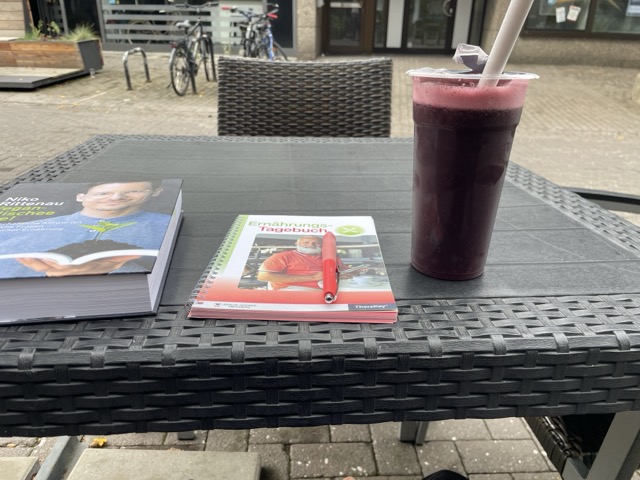
Now I have arrived at the city library. Let's continue with the critical nutrient, vitamin B2 (riboflavin):
- The vitamin B2 level in the blood should be over 60 micrograms/L.
- High doses of vitamin B2 color the urine yellow. This is harmless and shows that the vitamin is well absorbed. (I have also observed this in myself after taking high-dose vitamin B complex.)
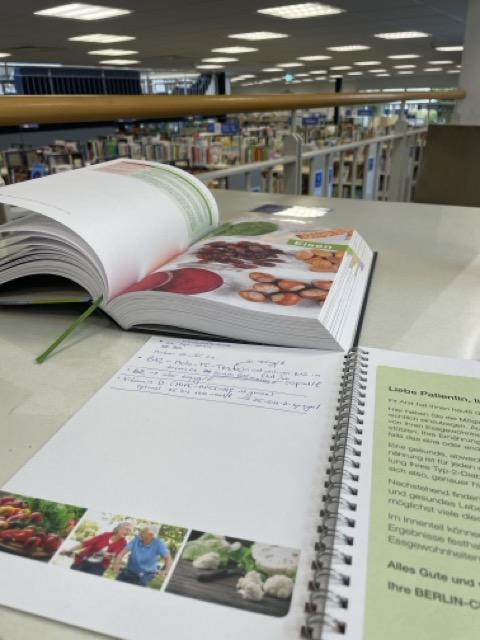
Let's move on to vitamin D:
- Many measurement methods are inaccurate. The most reliable method for measuring vitamin D in the blood is HLPC-APCI-MS.
- The vitamin D level should be between 75 and 150 nmol/L.
- People with overweight absorb vitamin D significantly worse than people with normal weight.
- The vitamin D level should not be higher than 150 nmol/L and not lower than 50 nmol/L.
- Indigenous people who are outside all day typically have a serum concentration of about 115 nmol/L.
- A daily intake of 40 to 60 IU per kilogram of body weight at normal weight is optimal. In my case, that would be 2480 to 3720 IU per day.
- In case of a deficiency, the daily dose is calculated using the formula "40 x (target value - starting value) x body weight". The dosage in IU is divided into 10,000 IU per day and taken until the calculated target value is reached.
Let's move on to iron:
- The optimal serum ferritin level is 30 micrograms/L. Or 30 ng/mL. (I'm not sure if this value is optimal. The optimal value is rather 100 ng/mL.)
- Paleolithic diet contained 100 g of fiber and 85 mg of iron per day. 6 times more iron than today! And 600 mg of vitamin C per day. 🤯
- For a number of diseases, the ferritin value can be higher despite iron deficiency. To rule this out, the inflammatory marker CRP should be measured as well.
- Multiple iron intake does not lead to multiple iron absorption. So it's better to take iron throughout the day.
- The smaller the iron store, the better the iron absorption.
- Pumpkin seeds contain 12.5 mg of iron per 100 g.
- To optimize iron absorption, the intake of phytic acids, polyphenols, high-dose zinc, calcium, medications, and alcohol should be reduced. And the intake of vitamin C, organic acids, beta-carotene, sulfur-containing substances (onion, leek, garlic) should be increased.
- Beta-carotene can multiply iron absorption. Sweet potato and carrots have 8 mg of beta-carotene per 100 g. Red bell pepper has 140 mg of vitamin C per 100 g.
Now it's time for calcium:
- The optimal value for an adult is between 2.09 and 2.54 mmol/L.
- 99% of calcium is in the teeth and bones.
- About 70% of the world's population is lactose intolerant.
- Calcium is just one of the many substances that are important for bone health. Magnesium, potassium, zinc, iron, selenium, copper, manganese, boron, and silicon, as well as vitamin D and other vitamins, are equally important. Milk alone would not be enough to have healthy bones and teeth.
- Sesame and nettles contain about 700 mg of calcium per 100 g. 🤯 Almonds and hazelnuts have about 250 mg of calcium per 100 g.
When I left the library, it had previously rained, and the ground was noticeably cooler. I stopped by Betterlife and bought organic vegetables that I would normally never take. But now I know I should eat as varied as possible. So, I bought pumpkin and parsnips. What I didn't like so much about Betterlife is that you have to weigh the vegetables, and after weighing, a label comes out. Although the vegetables are from Germany, unpackaged, and organic, unfortunately, some waste is generated through the purchase.
“How long will you hold out until October?” the cashier asked me. Apparently, walking barefoot becomes a badass action with dropping temperatures. People look much more at the feet, comment as they pass by, or speak to me directly.
“I don't know. I started walking barefoot in the spring, but 10° is the limit. But it could be that I just have to get used to it and can also endure lower temperatures. But I definitely have shoes,” I replied.
On the way home, two children asked me why I was walking barefoot. I joked because I have no shoes. Then they asked if I was afraid of getting hurt. I explained to them that the skin becomes more resistant over time. Then they wanted to do an experiment and throw snapdragons, which you throw on the ground and they pop, on my feet.
“Does it hurt?” asked the boy and threw the snapdragon on my foot.
“No, it just pinches a bit,” I replied.
Then the cute blonde girl threw the snapdragon directly at my feet but missed. I laughed and moved on.
At home, I first put the pumpkin in the defrosted fridge, and when I opened the fridge door, I was surprised by an unpleasant plastic smell. The fridge is really a nasty chemical bomb. I left it open so the plastic smell wouldn’t build up. Maybe I’ll sell it again. I don't really want to have such a plastic smell machine.
I prepared carrots and parsnips with garlic and some millet, refined with crushed nuts and flaxseed oil. This time I’m not using cutlery but exclusively my hands. I’m looking forward to trying this. I had tried eating with my hands once before on October 20, 2023, but unfortunately did not continue.
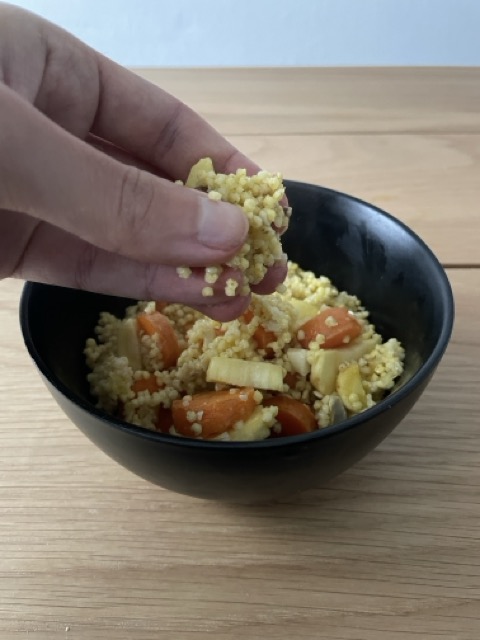
It’s so unusual to eat with hands, but it’s really fun. I feel the different temperatures of the vegetables and millet – the millet is much hotter than the vegetables. I immediately think of my skin microbiome, how it connects with the gut microbiome through eating with hands, forming a sort of friendship and exchanging with each other.
Out of curiosity, I took a spoon and ate a bite with it because I wondered why the simple food tastes so amazing. I don't know why, but eating with hands makes the food taste much better. It tastes much more intense, but I can't explain why. I get feelings of happiness when eating with my hands – it’s so strange, but it feels just great.
While eating, I look out the kitchen window at the dark clouds in the sky and hear a thunderstorm. Goosebumps spread across my skin. I feel that indescribable satisfaction again, a deep connection with nature.
After almost finishing the first portion in the bowl, I noticed that the leftover millet on the bottom required a bit of fiddling to eat; I still need a bit of practice.
What I also like about eating with hands is that I can pick out individual carrot pieces or a nut with the versatility of my fingers, or easily gather things together. This works much better with the hand than with a spoon or fork. And what kind of treatment is this for the hands? They are treated with high-quality linseed oil while eating. 😃 I think today will be the day I start regularly eating with my hands.
After eating, I continued learning about the nutrients I will be checking tomorrow.
The trace element, zinc:
- Zinc is located 60% in the muscles, 30% in the bones, and 10% in other organs.
- Zinc is needed for more than 300 enzymes, more than all other trace elements combined. 🤯
- The body's zinc store is small. Therefore, zinc must be continuously supplied through food.
- Pumpkin seeds contain 6.5 mg of zinc per 100 g. Peanuts and walnuts contain about 3 mg of zinc per 100 g.
- High-dose iron supplements should not be taken with zinc-containing meals because this inhibits zinc absorption. Citric acid (such as in oranges, kiwis) and acetic acid (such as in apricots or blueberries) improve zinc absorption. Sulfur-containing substances in garlic and onions also improve absorption.
Now to selenium:
- The selenium concentration in the blood should be between 110 and 130 µg/Liter.
- A good selenium supply is 1.5 µg per kilogram of body weight. So I need 93 µg of selenium per day. The intake of 300 µg of selenium per day should not be exceeded.
- The thyroid contains the most selenium in the body.
- Selenium is excreted through urine, stool, and breath. Too much selenium makes the breath smell similar to garlic.
- 2 to 6 Brazil nuts per day cover the selenium requirement.
And the last trace element I want to check is iodine:
- Blood supply is determined through urine. It should yield a value between 100 and 200 µg/Liter.
- If no iodized salt is used, 96% of people in Germany do not meet the iodine intake recommendation.
- The thyroid does not function well with both iodine deficiency and iodine excess.
- Lack of selenium, vitamin A, zinc, or iron reduces iodine utilization.
- The intake of 600 µg of iodine per day should not be exceeded.
Around 9:00 p.m., I went to bed and fell asleep quickly. Sleep well, until tomorrow! 😴